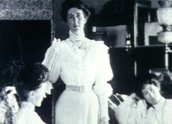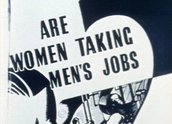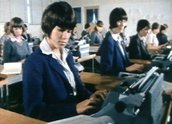


For Love or Money (1983)
Synopsis
Using a vast array of historical footage, the film proposes a history of women and work in Australia, from 1788 to 1983.
Curator’s notes
A concurrence of initiatives arising from the 1977 Women’s Film Production Workshop and the 1978 inaugural Women and Labour Conference, resulted in four filmmakers – Megan McMurchy, Margot Nash, Margot Oliver and Jeni Thornley – commencing a film history of Australian women at work. Meticulous research unearthed an extensive collection of material – feature films, home movies, news and newsreels, documentaries, television shows, commercials, photographs, radio shows, diaries, popular music, letters and interviews – dating back to the 18th century and showing women, of every decade and every background, at work in all its myriad forms. Over five years in the making, the film – an epic 109 minutes long – is set out in four parts: Hard Labour (1788-1914), Daughters of Toil (1914-1939), Working for the Duration (1939-1969) and Work of Value (1969-1983). A narration by Noni Hazlehurst connects hundreds of excerpts from hundreds of historical sources, painstakingly collected and reproduced. At a time when historical footage reproduction meant interpositives and internegatives, and costings per feet and frames, it’s almost impossible to imagine the methodical cataloguing and ordering of the material involved.
Released in the wake of films like The Song of the Shirt (UK 1979) and The Life and Times of Rosie the Riveter (US 1980), For Love or Money was one of a new genre of historical documentaries, where young filmmakers took command of the archive and used its images (both those that had helped determine national histories and those that had been denied a contribution to these histories) to attempt to reformulate – or at least refocus – collective memories. Most of these films today, some 25 years down the track, stand the test of time. For Love or Money is no exception.
However, while a film like The Song of the Shirt investigated a particular moment in history and used it to expand into broader political debates, For Love or Money set for itself an extraordinarily ambitious project. Using almost totally historical material and including only small segments of new footage, it embarked on a history encompassing the role of all Australian women (young, old, Indigenous, colonial, modern, white, non-Anglo, middle class, working class, et al) in both paid and unpaid work, over a 200 year period. There was almost no choice but to funnel this massive compilation into a chronology – albeit one with three sides. On one side is the story of the struggle for equality and better conditions in the broad spectrum of the paid workforce. On another side is a proposal for a radical analysis of women’s work as mothers, carers, householders and lovers. And on a third side is a dialogue on feminism and history.
It was the project’s ambition, and the consequences of that ambition, that generated criticism at the time of its release – in particular the film’s attempt to unify its content, and produce a single position (the narration’s ‘we’) from which to both speak about the content and to move forward into the future. In their 1987 essay 'For Love or Money: A Work of Loving’ (included in Don’t Shoot Darling), Ann Curthoys and Susan Dermody pointed out that ‘the rewards of this approach can be great, as the film amply shows. But the accompanying dangers – closely related to the blurring and blending of modes of address and appeal in the voice-over – are also great. The film risks being seen as eliciting a kind of homogenising sentimentalism, one that counters the whole vast work of its analysis of history.’
A decade later, Felicity Collins, in her 1998 essay 'The Experimental Practice of History in the Filmwork of Jeni Thornley’ (included in Screening the Past, Issue 3), argued for a retrospective viewing of the film ‘in the light of a renewed interest, since the late 1980s, of feminist film theorists in questions of history’. Collins saw the image of female unity in For Love or Money as ‘fragmented into multiple reminiscences which work against the unifying voice of the narrator and against the linearity of historicist time’. She went on to add however that the film attempts to subsume these ‘multiple reminiscences’ into ‘one temporality’, in order to find an resolution – that is, to find a position from where a feminist future can begin. The attempt results in what Collins saw as multiple endings to the film.
Today, another decade later, it’s these multiple endings that most strongly articulate a particular problem for the feminist telling of history. They point to why, even by the time For Love or Money was released, significant numbers of younger feminists had begun looking for new modes of identifying themselves. This unresolved problem of feminism and history was explored, in varying degrees and to greater extent and effect, in later films made by the filmmakers individually: To the Other Shore (directed by Jeni Thornley), Breathing Under Water (produced by Megan McMurchy) and Shadow Panic and Vacant Possession (both directed by Margot Nash).
Following its release, For Love or Money was accepted into just about every international film festival on the map, picking up a swag of awards on its travels. A book, For Love or Money: A Pictorial History of Women and Work in Australia, written by the three of the filmmakers (McMurchy, Oliver and Thornley), was released in conjunction with the film. Published by Penguin Books, the book was edited by Irina Dunn, with Lyndall Ryan the historical consultant.
Secondary curator’s notes
by Romaine MoretonFor Love or Money is an interesting documentary that, through archival footage and photographs, attempts to give a feminist perspective on the role of women in Australian history. The inclusion of archival footage of Indigenous women in traditional, urban and rural settings within various periods of history, is somewhat tentatively placed. The inclusion of stolen generation issues, assimilation practices, blackbirding – or the theft of Melanesian people for cheap labour – was included with good intentions by the filmmakers, but to link the issues of Indigenous womanhood with white womanhood is somewhat misleading.
While the story of the Suffragettes, the fight for equal pay for women and the historical struggle for equality for women that continues into the present day is greatly informative, the issue for Indigenous women is one of racism as well as sexism, for the struggle for liberty of Indigenous women, like Indigenous men, is the struggle against racism. The rights and privileges of white womanhood for example, are not the same simply in that Indigenous women endure fewer rights than white women. Indigenous men also, arguably, have less rights than white women. The feminist framing of Indigenous womanhood suggests that the struggle of Indigenous women is aligned with white womanhood, when in fact, the struggle for Indigenous women is, like Indigenous males, one against racism as well as subjugation based on gender.
- Overview
- Curator’s notes
- Video 3 clips

- Principal credits
- Find a copy
- Make a comment
- Add your review




